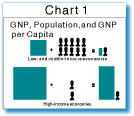|
|
| |
|
|
|
|
|
|
GNP per Capita
Gross national product (GNP) per capita is the dollar value of a country’s final output of goods and services in a year, divided by its population. It reflects the average income of a country’s citizens. Countries with a GNP per capita in 1995 of $9,386 or more are described as high income, between $766 and $9,385 as middle income, and $765 or less as low income.
What GNP per capita shows
GNP per capita shows what part of a country’s GNP each person would have if this GNP were divided equally. Knowing a country’s GNP per capita is a good first step toward understanding the country’s economic strengths and needs, as well as the general standard of living enjoyed by the average citizen. A country’s GNP per capita tends to be closely linked with other indicators that measure the social, economic, and environmental well-being of the country and its people. For example, generally people living in countries with higher GNP per capita tend to have longer life expectancies, higher literacy rates, better access to safe water, and lower infant mortality rates.
Economic productivity and growth
 Low- and middle-income countries produce about 20 percent of the world’s
goods and services, but have more than 80 percent of the world’s population. As Chart 1 illustrates,
this trend results in people in low- and middle income countries having a smaller share of the world’s goods and services
than people in high-income countries.
Low- and middle-income countries produce about 20 percent of the world’s
goods and services, but have more than 80 percent of the world’s population. As Chart 1 illustrates,
this trend results in people in low- and middle income countries having a smaller share of the world’s goods and services
than people in high-income countries.
A general objective of nations is to increase the size of their economies and hence their GNP per capita. Economic growth depends on people—both men and women—having better health, education, and work skills. It also depends on improving transportation, communication, and energy systems; having better tools and technology; having access to raw materials and capital; getting fair wages and prices for goods and services; encouraging savings and investment; increasing the value and variety of exports; and having better access to world markets to sell these exports.
Effects of population growth rate on GNP per capita
Between 1980 and 1995, GNP grew moderately in many low-income countries, although in some cases—most notably China—growth was substantial. However, in many developing countries, economic growth is often counteracted by rapid population growth. As a result, GNP per capita has tended to grow at a slower rate in low- and middle-income countries than in high-income countries. In fact, Chart 2 shows that GNP per capita growth has been negative in most low- and middle-income countries in the period 1980–1995.
Many countries are trying to slow their population growth in order to raise standards of living. In general, countries that have managed to increase their GNP per capita have tended to contain population growth while following sensible economic policies that can encourage stability and increases in both human and physical capital.
What GNP per capita does not show
GNP per capita helps measure the material output of a country, but it does not show what kinds of goods and services the country produces, whether all people share equally in the wealth of a country, or whether these people lead fulfilling lives.

Despite large differences in the GNP per capita of high-, middle-, and low-income countries, the trend across all countries is for the richest 20 percent of the population to earn incomes that are many times higher than the poorest 20 percent. To get a better picture of the standard of living in a country, you must go beyond GNP per capita to see how equitably income is distributed among all the people. Chart 3 depicts distribution patterns typical of low-, middle-, and high-income countries around the world.
GNP does not always capture activity in the informal economy, such as unreported cash payments for goods and services, bartering, or black market trading. The informal sector can generate a lot of income that never shows up in standard economic indicators. Many countries are encouraging programs that help people in the informal sector get loans and business training, with the goal that they eventually become part of the formal economy.(Case Study)
Some more issues...
Going beyond GNP per capita helps reveal other important development issues. For example, GNP per capita is given in dollars, but a dollar may buy more in one country than in another. To compare the actual purchasing power of per capita incomes across countries, you can look at purchasing power parity (PPP). Another issue is that GNP per capita does not recognize the costs of depleting natural resources and damaging the environment. The concept of natural resource accounting, although still being developed, strives to measure and allow for these costs.
Explore the Text | Text Library
| Copyright � 1998 IBRD/The World Bank |
[email protected] |